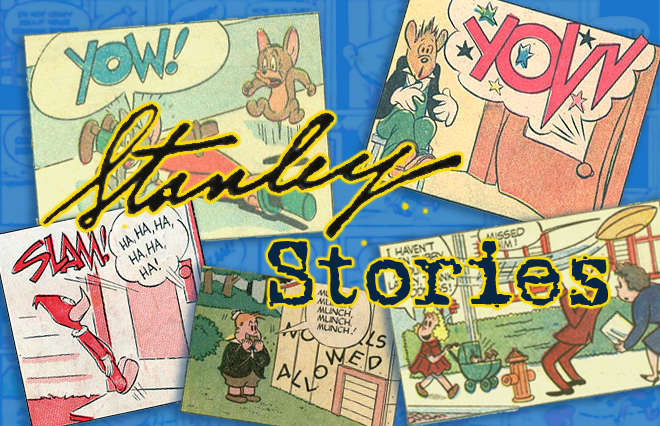Read, enjoy, and then we'll talk...
































Three persistent second-string Stanley themes merge in this story: the all-powerful, manipulative rich, evil midgets posing as children, and magicians.
All of these themes surface in Little Lulu and Nancy from time to time. It's notable to find all three in one story.
Less plot-driven than most of Stanley's book-length stories, "Easter Party" has an engagingly loose, spontaneous feeling. I don't think Stanley spent much time or effort in writing it.
The anonymous artist was not among Western Publishing's finer craftsmen. His work appears in New Funnies during that title's Stanley period. The boldness and agitation of his figures may stem more from Stanley's layouts. His actual drawing leaves much to be desired. The lack of polish hurts the story overall.
Stanley's protagonists, as here, are usually under-priveliged: in need of money or security. The rich, always a symbolic figure in the Stanley universe (and usually sinister in nature), serve as a temporary open door to a better world.
The Van Doughs are, as Stanley's rich go, benevolent--if self-absorbed and presumptuous. At story's start, Mrs. Van Dough stalks Oswald and his domestic partner, Toby, through a department store. She demands Oswald's presence at her son's party. To her view, he has nothing better to do, being a mere peasant.
Unlike the rich families of Lulu and Nancy, the Van Doughs are seemingly kind people. Stanley's dislike of the rich never lets the reader feel comfortable in such refined surroundings. There is always an element of threat.
In this story, the threat comes in the form of a masquerading midget who impersonates the Van Doughs' wussy son, Algernon. Mrs. Van Dough notices that her formerly benign son is now a grade-A asshole, but assumes it's just a phase he's going through. She has garden parties and croquet matches to think about. She is also (ahem) nearsighted. This is the perfect ailment for a wealthy Stanley character. It's also the lynchpin of the story's wafer-thin plot.
No Mr. Van Dough is seen. Makes one wonder, as Stanley typically has his wealthy married and settled. Perhaps he was a casualty of the Great Funny-Animal world war--erased before his time.
The centerpiece of "The Garden Party" is a lengthy battle-of-wits between Os and Toby and the faux-Algernon. The mean-spirited, larcenous fake Algy does his best to publicly humiliate and confound our heroes as they blunder their way through an improvised magic act.
This section of the story reads like a storyboard for an animated cartoon. It shows Stanley's cleverness and resourcefulness. Such a sequence would be tedious in most funny-animal comix. Like Carl Barks, Stanley had an understanding of formulae, and how to confound them.
The breezy grace of this long sequence is unique in Stanley's work. It's refreshing to see him let go of the narrative, and just let amusing things happen, one after another.
The magic act is a perfect set-up for these seemingly spontaneous events. Poor, bland Oswald is given quite an honor; the magician is a special figure in the Stanley universe. Whether a stage conjurer, or an actual wizard-type (e.g., Uncle Eek in Nancy), the magician enjoys a special status.
It's a kind gesture to Oswald, who had been abandoned as a screen character after the 1930s. Stolen from Walt Disney in the late 1920s, Oswald was continued, after a brief transitional period, by Walter Lantz's animation studio.
The Oswald cartoons of the pre-code talkie era are imaginative, freaky things. A young Fred "Tex" Avery was on the Lantz staff at the time, and certain cartoons from 1930-1934 show his developing sense of humor.
Oswald followed the blanding trend of Mickey Mouse as the '30s staggered on. His newfound wimpiness proved his undoing. A cuter, cuddlier, less dangerous character runs out of things to do. Oswald was quietly dumped at the end of Lantz's 1938 cartoon season.
He was revived for one mediocre musical cartoon in 1943. Though he appeared on Lantz-made TV shows in the 1960s, his career as a screen star was kaput. He was used in merchandising and licensing. Early TV reruns of his Lanta cartoons may have revived his marketability in the late 1950s. His last funnybook appearance was in 1962.
You can see some of Oswald's animated antics on DVD: Disney put out a two-disc set of all the surviving silent cartoons. Selections from the talkie Lantz era are on the two sets of Woody Woodpecker and Friends, also indispensible for the cartoons directed by James Culhane.
Oswald was also among the first licensed characters for the funny-books, via his February, 1935 appearance in the first issue of New Fun Comics. an early effort of the company soon known as DC,
There you go: all the Oswald Rabbit factoids you didn't think you needed to know. Well, now you do. And, now--adieu!

No comments:
Post a Comment